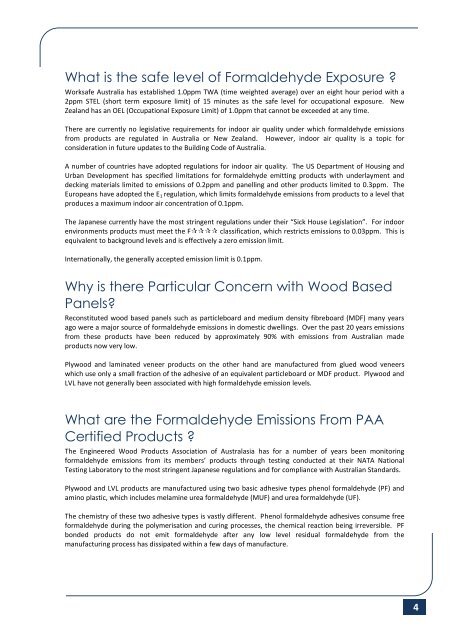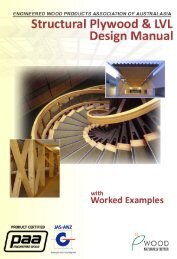Formaldehyde Emissions - Engineered Wood Products Association ...
Formaldehyde Emissions - Engineered Wood Products Association ...
Formaldehyde Emissions - Engineered Wood Products Association ...
You also want an ePaper? Increase the reach of your titles
YUMPU automatically turns print PDFs into web optimized ePapers that Google loves.
What is the safe level of <strong>Formaldehyde</strong> Exposure ?<br />
Worksafe Australia has established 1.0ppm TWA (time weighted average) over an eight hour period with a<br />
2ppm STEL (short term exposure limit) of 15 minutes as the safe level for occupational exposure. New<br />
Zealand has an OEL (Occupational Exposure Limit) of 1.0ppm that cannot be exceeded at any time.<br />
There are currently no legislative requirements for indoor air quality under which formaldehyde emissions<br />
from products are regulated in Australia or New Zealand. However, indoor air quality is a topic for<br />
consideration in future updates to the Building Code of Australia.<br />
A number of countries have adopted regulations for indoor air quality. The US Department of Housing and<br />
Urban Development has specified limitations for formaldehyde emitting products with underlayment and<br />
decking materials limited to emissions of 0.2ppm and panelling and other products limited to 0.3ppm. The<br />
Europeans have adopted the E 1 regulation, which limits formaldehyde emissions from products to a level that<br />
produces a maximum indoor air concentration of 0.1ppm.<br />
The Japanese currently have the most stringent regulations under their “Sick House Legislation”. For indoor<br />
environments products must meet the F classification, which restricts emissions to 0.03ppm. This is<br />
equivalent to background levels and is effectively a zero emission limit.<br />
Internationally, the generally accepted emission limit is 0.1ppm.<br />
Why is there Particular Concern with <strong>Wood</strong> Based<br />
Panels?<br />
Reconstituted wood based panels such as particleboard and medium density fibreboard (MDF) many years<br />
ago were a major source of formaldehyde emissions in domestic dwellings. Over the past 20 years emissions<br />
from these products have been reduced by approximately 90% with emissions from Australian made<br />
products now very low.<br />
Plywood and laminated veneer products on the other hand are manufactured from glued wood veneers<br />
which use only a small fraction of the adhesive of an equivalent particleboard or MDF product. Plywood and<br />
LVL have not generally been associated with high formaldehyde emission levels.<br />
What are the <strong>Formaldehyde</strong> <strong>Emissions</strong> From PAA<br />
Certified <strong>Products</strong> ?<br />
The <strong>Engineered</strong> <strong>Wood</strong> <strong>Products</strong> <strong>Association</strong> of Australasia has for a number of years been monitoring<br />
formaldehyde emissions from its members’ products through testing conducted at their NATA National<br />
Testing Laboratory to the most stringent Japanese regulations and for compliance with Australian Standards.<br />
Plywood and LVL products are manufactured using two basic adhesive types phenol formaldehyde (PF) and<br />
amino plastic, which includes melamine urea formaldehyde (MUF) and urea formaldehyde (UF).<br />
The chemistry of these two adhesive types is vastly different. Phenol formaldehyde adhesives consume free<br />
formaldehyde during the polymerisation and curing processes, the chemical reaction being irreversible. PF<br />
bonded products do not emit formaldehyde after any low level residual formaldehyde from the<br />
manufacturing process has dissipated within a few days of manufacture.<br />
4

















